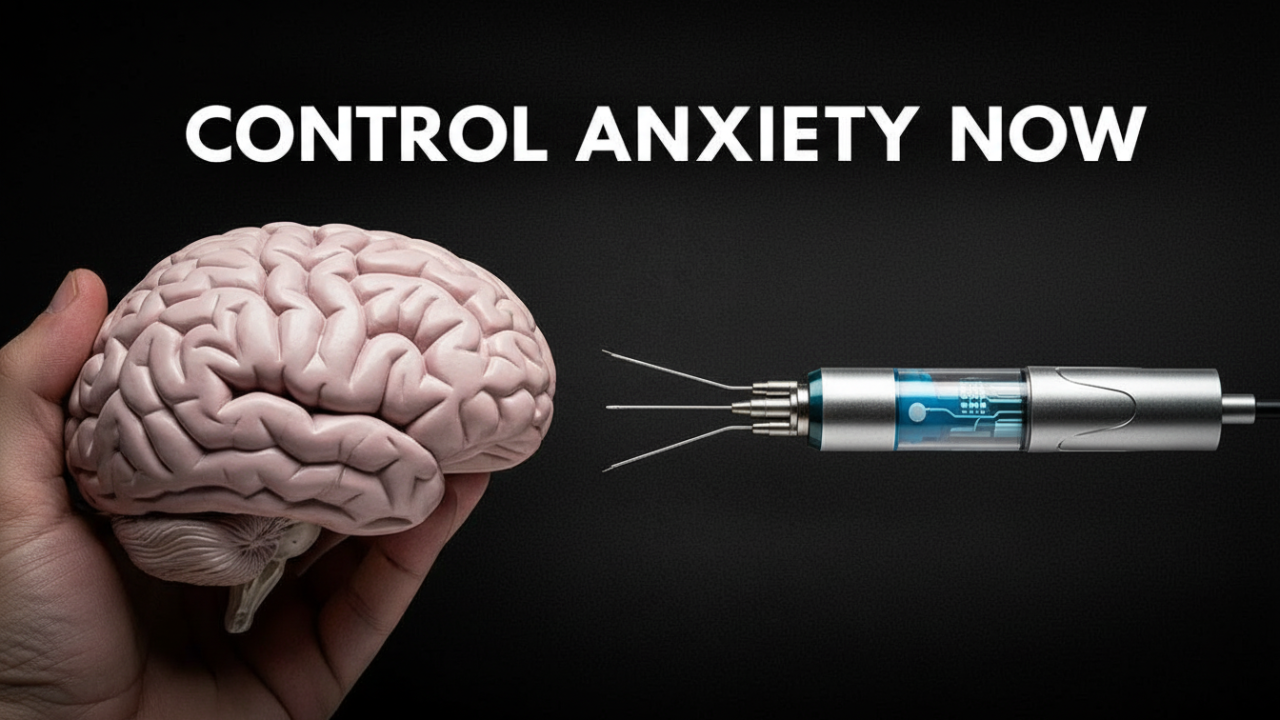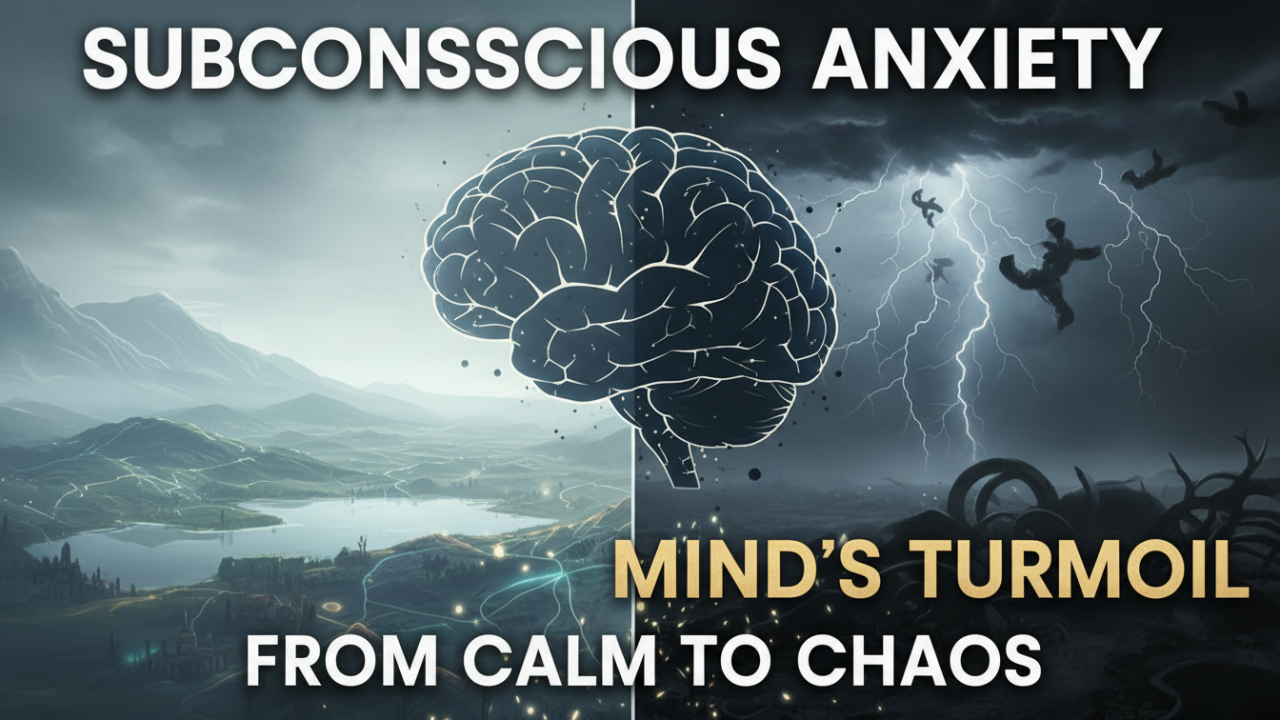Do you ever feel like your anxiety is a switch that’s just stuck on? You try to talk yourself down, to reason with the fear, but nothing works. The racing thoughts, the tight chest, the feeling of dread… they just keep looping. It’s exhausting, and it can feel like you’re trapped running the same painful script over and over again.
What if I told you this isn’t a life sentence? That you’re not broken, and this pattern isn’t permanent? What if the very wiring of your brain that creates anxiety is the exact thing we can use to undo it?
That science is called neuroplasticity, and it’s your brain’s natural superpower. It means your brain isn’t fixed or hardwired. It’s adaptable, and you have the power to consciously reshape it. In this article, we’ll break down the science behind the anxious brain. Then, I’ll guide you, step-by-step, through five powerful exercises to start rewiring your brain for lasting calm. This isn’t about just coping; it’s about changing your relationship with anxiety from the inside out.
This book is scientific documentary of the Kingdom of God.
Section 1: The Problem – Why We Get Stuck in the “Anxious Loop”
To get out of the anxiety loop, we first need to see how we got in. Picture your brain as a dense forest. Every time you have a thought or feel an emotion, you create a tiny path in that forest.
Now, let’s say you get a jolt of anxiety thinking about a big presentation at work. You’ve just walked down a specific path. That thought triggers your brain’s threat detector, a little almond-shaped area called the amygdala.
The amygdala is your internal smoke detector. Its only job is to scream “Fire!” when it senses a threat—whether that threat is a tiger in the grass or a tough meeting with your boss. When the alarm sounds, your body gets flooded with stress hormones like cortisol and adrenaline. Your heart pounds, your breathing gets shallow, your muscles clench up. This is the classic fight-or-flight response, a survival mechanism that’s meant to keep you safe from immediate danger.
In a balanced response, another part of your brain, the prefrontal cortex, steps in. Think of the prefrontal cortex as the CEO of your brain. It handles rational thinking and emotional regulation. It looks at the situation and says, “Okay, amygdala, thanks for the heads-up, but this is just a presentation. It’s stressful, but it’s not life-or-death. We can stand down.” The prefrontal cortex sends the “all-clear” signal, and the stress response fades.
But in a brain prone to anxiety, this system gets out of whack. The amygdala becomes overactive and hypersensitive. It’s like a smoke detector that goes off for burnt toast, or even just someone lighting a candle. It starts flagging everyday situations as major threats.
At the same time, the prefrontal cortex can become underactive. It struggles to send that “calm down” signal. The CEO is overwhelmed and can’t manage the panicked employee. This kicks off a vicious cycle. The more the amygdala fires, the more you feel the physical sensations of anxiety. Your brain then takes those feelings as more proof that there must be a real danger.
Let’s go back to our forest. Each time you have that anxious thought about the presentation, you walk down the same path. The first time, it’s just a faint trail. But after a hundred or a thousand times, that path becomes a well-worn track. Eventually, it turns into a six-lane superhighway. Your brain gets so efficient at running this anxiety script it becomes the default. It doesn’t even think; it just automatically merges onto the anxiety highway.
This is the anxiety loop. A trigger leads to an anxious thought, which fires up the amygdala, which creates physical symptoms, which reinforces the belief that you’re in danger, which strengthens that neural pathway. And the more you avoid the things that make you anxious, the more you confirm to your brain that they are, in fact, dangerous. Avoidance is like putting up a giant neon sign on that anxiety highway that says, “Yes! This is the right way! Danger ahead!”
This is why anxiety feels so automatic and out of control. You’ve basically practiced being anxious so much that your brain has become an expert at it. You’ve built superhighways for fear. But here’s the game-changing truth: those highways aren’t permanent. And that brings us to the solution.
Section 2: The Anxiety Solution – You Can Rewire Your Brain with Neuroplasticity
If your brain can learn anxiety, it can learn calm. That is the promise of neuroplasticity. Neuroplasticity is simply your brain’s ability to change its structure and function based on experience. It’s the “plastic,” adaptable quality that lets you learn a new language, master the guitar, or even recover from a brain injury. And for us, it’s our ticket out of the anxiety loop.
Think back to our forest. Neuroplasticity is your ability to consciously stop using the anxiety highway and start forging a new path. At first, this new path—one of calm, rational thought, and self-compassion—is going to be tough going. You’ll have to push through thick underbrush and overgrown branches. It takes real effort and intention.
But every time you choose this new response, every time you guide your brain down this new trail, you make it a little clearer and a little easier to travel. With repetition, this new path becomes your go-to. Meanwhile, the old anxiety highway, from lack of use, starts to break down. Weeds sprout in the cracks. The brain is incredibly efficient; it prunes away connections that are no longer being used.
Over time, your new path of calm becomes the default. It becomes the new, smooth, easy-to-travel highway. This is what we call self-directed neuroplasticity: intentionally using your thoughts and actions to change your brain for the better.
So how does this actually work in the brain? When you practice new thoughts or behaviors, you stimulate the growth of new connections, or synapses, between your neurons. The more you practice, the stronger these connections get. You’ve probably heard the phrase, “Neurons that fire together, wire together.” By repeatedly activating new circuits for calmness and safety, you physically strengthen them.
This process also releases key brain chemicals, like Brain-Derived Neurotrophic Factor, or BDNF. Think of BDNF as fertilizer for your brain cells. It helps existing neurons survive and encourages the growth of new ones. Many of the exercises we’re about to cover have been shown to boost BDNF, literally helping you build a healthier, more resilient brain.
The key takeaway here is empowering: You are not a victim of your brain’s wiring. You are the architect. You have the ability to lay down new tracks and build a brain that’s fundamentally less anxious. The journey from anxiety to calm isn’t about finding a magic pill; it’s a construction project. And every construction project needs a blueprint and some tools.
The good news is, the work isn’t as hard as you might think. It involves simple, targeted exercises that, when practiced consistently, create powerful and lasting change. So, let’s get to the tools.
Section 3: The “How-To” – Your 5 Neuroplasticity Exercises for Anxiety Relief
This is where we get practical. We’re going to walk through five guided exercises. For each one, I’ll explain the science of how it works, and then I’ll guide you through it. Just remember, consistency beats intensity. A few minutes every day is way more effective than one long session once a week. You’re training a muscle, and that takes regular practice.
Anxiety Exercise 1: Focused Attention & The 4-7-8 Breath
The Science: This first exercise is a one-two punch that gets right to the heart of the anxiety response. First, we use deep breathing. When you’re anxious, your breath gets shallow and fast, kicking on your “fight or flight” system. Slow, controlled breathing, like the 4-7-8 technique, does the exact opposite. It directly activates your “rest and digest” system, sending a powerful signal from your body to your brain that you are safe. It physically interrupts the anxiety feedback loop by lowering your heart rate and reducing stress hormones.
Next, we add Focused Attention. Anxiety often feels like your mind is just jumping from one worry to the next. By training yourself to hold your focus on a single, neutral thing—like your breath—you are strengthening the neural circuits in your prefrontal cortex, the brain’s “CEO.” You’re building your brain’s attention muscle. This makes it easier to disengage from anxious thoughts and choose where to put your focus. Research shows that even short bursts of meditation can start to grow gray matter in brain regions tied to emotional regulation.
The Guided Exercise:
Find a comfortable position—sitting in a chair with your feet on the floor, or lying on your back. Gently close your eyes. Let’s just start by noticing your body. Feel where it makes contact with the chair or the floor. Let yourself arrive right here, in this moment.
Now, bring your attention to your breath. Don’t try to change it. Just notice its natural rhythm. Notice the feeling of the air coming in through your nose, and going back out.
Okay, now we’ll begin the 4-7-8 breathing. I’ll guide you through the first few. You’ll inhale quietly through your nose for a count of four, hold for a count of seven, and then exhale fully through your mouth with a gentle “whoosh” sound for a count of eight.
Let’s begin. First, just exhale completely.
Now, close your mouth and inhale quietly through your nose for… one… two… three… four.
Hold your breath for… one… two… three… four… five… six… seven.
And exhale through your mouth with a whoosh for… one… two… three… four… five… six… seven… eight.
That was one breath. Let’s do it again. Inhale through your nose… one… two… three… four.
Hold… one… two… three… four… five… six… seven.
Exhale… one… two… three… four… five… six… seven… eight.
One more time together. Inhale… one… two… three… four.
Hold… one… two… three… four… five… six… seven.
Exhale… one… two…three… four… five… six… seven… eight.
Now, continue on your own for a few more rounds. Focus all your attention on the count and the feeling of your breath.
(Pause for 30 seconds)
Now, let your breath return to its natural, easy rhythm. Your only job is to focus on the sensation of breathing. Feel the rise and fall of your belly. Feel the cool air as it enters, and the warm air as it leaves.
Your mind will wander. That’s just what minds do. When you notice it has wandered off to a thought, a worry, or a memory, that is a moment of victory. You became aware! Without any judgment, just gently acknowledge the thought, and then guide your attention right back to your breath.
Think of your attention like a puppy you’re training. You tell it to stay, but it wanders off. You don’t get mad at the puppy. You just gently and kindly bring it back. Every single time you guide your attention back to your breath, you’re doing one rep for your prefrontal cortex. You are strengthening that focus muscle. You are carving that new neural path.
Let’s sit with this for another minute in silence. Just you and your breath. When the puppy wanders, just bring it back.
(Pause for 60 seconds)
Slowly, bring your awareness back to the room. Notice any sounds around you. Feel the air on your skin. When you’re ready, gently open your eyes.
Take a moment. Just notice how you feel. A little calmer? More centered? By doing this for just 5-10 minutes a day, you are actively rewiring your brain’s response to stress.
Anxiety Exercise 2: Cognitive Reframing – Challenging Anxious Thoughts
The Science: This is where you directly apply self-directed neuroplasticity to your thoughts. Anxiety loves to feed on automatic negative thoughts and unhelpful thinking patterns, like catastrophizing—assuming the absolute worst-case scenario.
Cognitive reframing is simply the act of identifying these warped thoughts, questioning if they’re actually true, and then consciously replacing them with more balanced, realistic ones. Every time you catch an anxious thought and challenge it, you weaken the neural pathway that supports it. And every time you introduce a more balanced thought, you start building a new neural pathway. You are literally rewriting the anxiety scripts that run on autopilot.
The Guided Exercise:
You can do this exercise anytime, anywhere. It’s a three-step process: Identify, Challenge, and Reframe. It’s powerful to do in your head, but even more so if you write it down.
Step 1: Identify the Anxious Thought. The second you feel that spike of anxiety, ask yourself: “What, exactly, is the thought running through my head right now?” Be specific. Not just “I’m worried about work.” Is it, “If I mess up this presentation, everyone will think I’m an idiot and I’ll get fired”? That’s the one. Write it down.
Step 2: Challenge the Thought. Now, put on your detective hat. It’s time to cross-examine this thought. Ask yourself these questions, and be brutally honest:
What’s the evidence FOR this thought? What hard facts prove that one mistake means you’re fired? Has it happened to anyone else you know?
What’s the evidence AGAINST this thought? How many times have you made a small mistake and nothing happened? What good feedback have you gotten at your job? What are other, more likely outcomes?
Am I using a thinking trap? Is this catastrophizing? Am I jumping to conclusions or mind-reading? Just naming the distortion can take away its power.
What would I tell my best friend if they had this thought? (We’re usually much kinder to them than to ourselves).
Let’s use our example: “If I mess up, everyone will think I’m an idiot and I’ll get fired.”
Evidence for: “My boss is very particular.” (Notice this is a feeling, not a fact proving you’ll be fired). Evidence against: “I’ve made small mistakes before and no one cared. My last review was good. The company doesn’t fire people for one mistake. My coworkers are mostly supportive.” Distortion: “This is 100% catastrophizing and mind-reading. I’m assuming the worst and pretending I know what everyone else is thinking.”
Step 3: Reframe the Thought. Now, create a new thought. It doesn’t have to be super positive, just more balanced and realistic.
The original anxious thought: “If I make a mistake in my presentation, everyone will think I’m incompetent and I’ll get fired.”
A powerful reframe: “I’m nervous about my presentation because I want to do well, and that’s normal. I’ll prepare as best I can. If I make a mistake, it’s not the end of the world. The most likely outcome is that nobody will notice, or they’ll get it because everyone makes mistakes. My value here isn’t based on one single presentation.”
Say this new thought to yourself. Write it down. Feel the shift. You just took the wheel. You stepped off the anxiety highway and started paving a new road based on facts and self-compassion. Do this consistently, and your brain will start to question anxious thoughts automatically instead of just accepting them as fact.
Anxiety Exercise 3: Positive Visualization & Imagined Safety
The Science: Here’s a wild thought: your brain doesn’t always know the difference between a vividly imagined event and a real one. When you worry, you are using visualization to rehearse for failure. You’re running mental simulations of everything going wrong, which just strengthens the neural pathways for fear.
Positive visualization flips that script. By vividly imagining a safe, calm place or a successful outcome, you activate the neural circuits for safety, calm, and confidence. You’re rehearsing for success. This builds up your inner resources and creates a “go-to” state of calm that you can access more easily over time.
The Guided Exercise:
Let’s start by creating a “Safe Place” in your mind. This is your mental sanctuary, a place you can retreat to anytime you feel overwhelmed.
Close your eyes and take a couple of those 4-7-8 breaths we practiced, just to settle your nervous system.
Now, imagine a place where you feel completely safe, peaceful, and at ease. It could be a real place you’ve been—a quiet beach, a cozy room. Or it can be totally imaginary. No rules here.
Once you have your place, let’s bring it to life using all your senses.
What do you see? Look around. Notice the colors, the light. Are there trees? Water? A fireplace? Zoom in on the details—the texture of a leaf, the grain of wood.
What do you hear? Listen. Is it the sound of waves? Birds chirping? A crackling fire? Or is it just peaceful silence?
What do you feel? Feel the air on your skin. Is it warm sun? A cool breeze? What are you sitting or standing on? Soft sand? A comfy chair?
What do you smell? Breathe in the scents. Saltwater? Pine trees? Freshly brewed tea?
Is there a taste? Maybe the salt on the air, or a warm drink you’re holding.
Now, just be in this place for a few moments. Let that feeling of safety and peace wash over you. Really feel it in your body. Know that this place is yours. It’s inside you, and you can come back here anytime you need to.
(Pause for 60 seconds)
You can use this same technique for a specific event that’s making you anxious, like a job interview. Spend time imagining it going perfectly. See yourself walking in confidently, answering questions clearly, building a great rapport, and leaving feeling proud of yourself. Run this mental movie over and over. You’re paving a neural pathway for success, making it a more likely reality.
When you’re ready, slowly bring your awareness back to the present and open your eyes.
Anxiety Exercise 4: Sensory Grounding – The 5-4-3-2-1 Method
The Science: When you’re in an anxiety spiral, your mind is usually obsessing about the future (what might happen) or the past (what did happen). Grounding techniques are designed to yank your attention out of your head and anchor it firmly in the present moment. By deliberately focusing on what your five senses are telling you right now, you redirect your brain’s resources away from the panicking amygdala and toward the parts that process sensory input. It acts like a circuit breaker for the anxiety loop, giving you immediate relief and proving to your brain that in this very moment, you are safe.
The Guided Exercise:
This technique is simple, powerful, and you can do it anywhere without anyone even knowing. The moment you feel that anxiety starting to build, just start the process. Look around and silently name:
5 things you can SEE: Notice the little things. The grain on the table. A crack in the pavement. The way light hits a glass. The specific color of a pen. Name them. “I see a green pen. I see my fingernail. I see a dust speck in the air.”
4 things you can FEEL: Bring your awareness to your sense of touch. Feel the texture of your jeans on your skin. The smoothness of your phone. The feeling of your feet flat on the floor. “I feel the soft fabric of my sweater. I feel the hard desk. I feel the cool air from the vent.”
3 things you can HEAR: Listen closely and pick out three distinct sounds. The hum of your computer. Distant traffic. Your own breathing. “I hear a keyboard clicking. I hear birds outside. I hear the fridge humming.”
2 things you can SMELL: This can be tricky, but try to find two scents. Your coffee? Your soap? The room itself? If you can’t smell anything, just recall two of your favorite smells. “I smell my coffee. I smell the paper in this book.”
1 thing you can TASTE: What can you taste right now? The hint of your morning toothpaste? A sip of water? Or just the neutral sensation of your tongue in your mouth. “I taste mint from my gum.”
After you finish, take one slow, deep breath. Notice how you’ve been pulled from the tornado of your thoughts and planted firmly in the present moment. This exercise teaches your brain that it can shift its focus from internal “threats” to neutral, external information, which calms the whole system down.
Anxiety Exercise 5: Novelty and Movement – Learning a New Skill
The Science: Anxiety has a way of making our worlds feel smaller. We get stuck in rigid routines and thought patterns. Introducing novelty and learning new things is a powerful way to fight this and boost neuroplasticity. When you learn something new—especially a physical skill like juggling, dancing, or playing an instrument—you force your brain to build brand new neural pathways. This improves your brain’s overall ability to change and adapt.
Physical exercise itself is a powerhouse for neuroplasticity. It increases blood flow to the brain, releases mood-boosting endorphins, and ramps up production of that brain fertilizer, BDNF. Combining novelty with movement gives you a double-whammy of brain-rewiring benefits. It’s also a great distraction from anxious thoughts and gives you a sense of accomplishment, which builds real confidence.
The Guided Exercise:
This one is less of a guided meditation and more of a fun assignment for your life. Your task is to intentionally introduce something new.
Choose a new skill to learn. Pick something that is challenging but also fun. It should require your full attention. Some ideas:
Learn a few chords on a ukulele from a YouTube video.
Try a beginner’s tai chi or yoga class online.
Learn to juggle with scarves (they’re slower and easier than balls).
Download a language app and learn 5 new words a day.
Try writing with your non-dominant hand for five minutes every day.
Commit to just 10-15 minutes a day. The goal isn’t to become a master; the goal is the process of learning. When you’re doing it, be fully present. Notice the awkwardness, the small wins, the focus it requires. That’s the feeling of your brain building new roads.
Sprinkle small novelties into your routine. It doesn’t always have to be a big new skill.
Take a different route on your daily walk.
Brush your teeth with your other hand.
Listen to a new type of music or a podcast on a topic you know nothing about.
By embracing novelty, you’re sending your brain a clear message: “We are flexible. We are adaptable. We are not stuck.” This creates a growth mindset that spills over into how you see your anxiety—not as a permanent state, but as a malleable pattern that you have the power to change.
Building Resilience and Call-to-Action
You now have five powerful tools in your neuroplasticity toolkit. We’ve covered breathing to calm your body, reframing to change your thoughts, visualization to build safety, grounding to anchor you in the present, and novelty to keep your brain flexible.
The most important thing to remember is that this is a practice. You didn’t build those anxiety highways overnight, and you won’t build the new highways of calm overnight either. Be patient with yourself. Be kind to yourself. Some days will be easier than others. Consistency is what matters. Every single time you do one of these exercises, you’re casting a vote for a calmer, more resilient brain.
If you found this helpful and you want to keep learning science-backed ways to take charge of your mental well-being, please subscribe to the channel and turn on notifications. It helps us create more free content like this, and you won’t miss what’s next.
Conclusion
I want to leave you with this: Anxiety is not who you are. It’s a pattern of thought and a physical response that your brain has learned. And anything that has been learned can be unlearned. Neuroplasticity isn’t just a cool science word; it’s proof that you have the power to change your own mind, your own brain, and your own life.
You have the blueprint and the tools. Start small, stay consistent, and trust in your brain’s incredible capacity to heal. You’ve got this.







